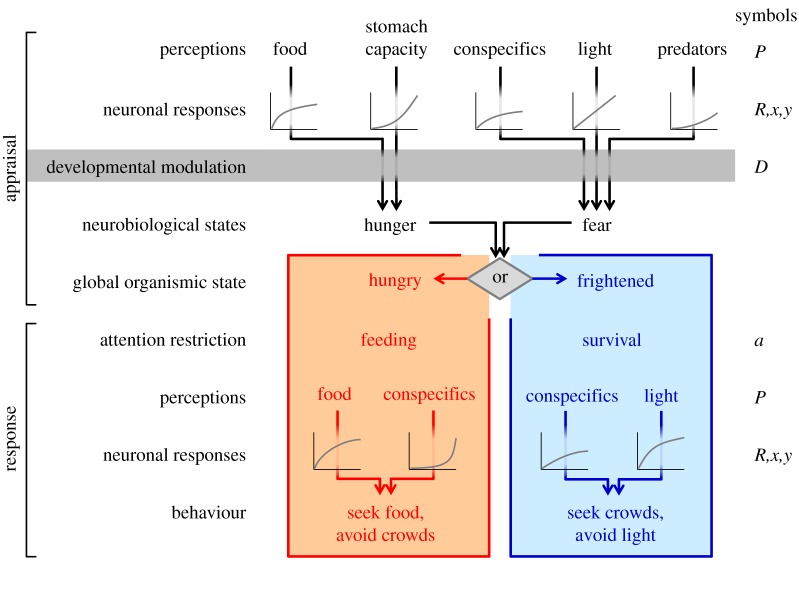Figure 1.
How emotions translate perception stimuli into behavioural responses in the model of Giske et al. [24] and in this paper. Each type of emotional stimuli contributes to an emotional appraisal through neuronal response, developmental modulation and competition among hunger and fear. The strength of each neuronal response R is individual and depends on the strength of the perception P and two genes specific to each neuronal response (x and y): R = (P/y)x/⌊1 + (P/y)x⌋. This equation gives a curve which, depending on the alleles of x and y in this individual, can be concave, sigmoidal, nearly linear or convex, as illustrated in the neuronal response cartoons in this figure and shown in figure 5. Internal signals related to development D are also individual and may amplify the strength of inputs to hunger (D) or fear (1 – D) over the other. The strengths of the competing neurobiological states in the hunger and fear survival circuits are then  and
and  , respectively. (The subscript A indicates that these are neuronal responses involved in the emotional appraisal.) The emotional appraisal ends with the stronger of these determining the global organismic state of the organism [28]. The emotional response is specific to the global organismic state and includes physiology and behaviour. The physiological response to this emotional appraisal is an attention restriction of the organism. In the processing of its behaviours, it thus re-evaluates a subset of its sensory information in its current depth z and the immediate depths above and below. Hungry individuals (neuronal response subscript H) will value food as positive and competitors as negative and ignore other information:
, respectively. (The subscript A indicates that these are neuronal responses involved in the emotional appraisal.) The emotional appraisal ends with the stronger of these determining the global organismic state of the organism [28]. The emotional response is specific to the global organismic state and includes physiology and behaviour. The physiological response to this emotional appraisal is an attention restriction of the organism. In the processing of its behaviours, it thus re-evaluates a subset of its sensory information in its current depth z and the immediate depths above and below. Hungry individuals (neuronal response subscript H) will value food as positive and competitors as negative and ignore other information:  . Frightened individuals (subscript F) will regard light as negative and conspecifics as positive:
. Frightened individuals (subscript F) will regard light as negative and conspecifics as positive:  . When the relevant behaviour is executed, the animal starts over on top with new emotional stimuli. Adapted from [24].
. When the relevant behaviour is executed, the animal starts over on top with new emotional stimuli. Adapted from [24].

